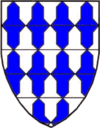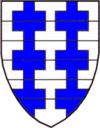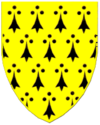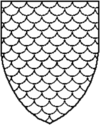Heraldic Tinctures: Difference between revisions
From Compendum Caidis
Jump to navigationJump to search
mNo edit summary |
mNo edit summary |
||
| Line 37: | Line 37: | ||
| Papellone || Fur || [[File:Fur-Papellone.png|100px]] | | Papellone || Fur || [[File:Fur-Papellone.png|100px]] | ||
|} | |} | ||
==Stains== | |||
Stains (stainand colours or staynard colours): are generally not used in SCA Heraldry. In medieval heraldry, the use of a stain represents a less-than honorable augmentation (abatement or rebatement) imposed by an heraldic authority or by royal decree for misconduct. These colours include: | |||
Murrey: Deep mulberry-coloured, or reddish purpl (Darker than Purpure). | |||
Sanguine: Blood-red (darker than Gules) | |||
Tenné (tawny): orange-tawny colour, though orange is considered distinct in continental European and African heraldic traditions. | |||
Revision as of 19:10, 20 November 2022
Heraldic Tinctures: Tincture is the limited palette of colors and patterns used in heraldry. They are classified as metals, colours, or furs.
Stains
Stains (stainand colours or staynard colours): are generally not used in SCA Heraldry. In medieval heraldry, the use of a stain represents a less-than honorable augmentation (abatement or rebatement) imposed by an heraldic authority or by royal decree for misconduct. These colours include: Murrey: Deep mulberry-coloured, or reddish purpl (Darker than Purpure). Sanguine: Blood-red (darker than Gules) Tenné (tawny): orange-tawny colour, though orange is considered distinct in continental European and African heraldic traditions.















